Opioid Addiction and Abuse Epidemic Report: Strategies and Treatment
VerifiedAdded on 2021/06/15
|16
|4873
|14
Report
AI Summary
This report delves into the opioid addiction and abuse epidemic, a critical global health concern. It begins by defining opioids and highlighting their potential for misuse, leading to severe consequences. The report explores the historical context of the epidemic, tracing its roots to the increased prescription of opioids in the 1990s and the subsequent rise in addiction rates. It examines the factors contributing to the epidemic, including over-prescription, marketing tactics, and the complex interplay of healthcare systems across different countries. The report then focuses on adaptive treatment strategies, particularly the Sequential Multiple Assignment Randomized Trial (SMART) method, as a means to personalize and improve treatment approaches. It discusses the importance of considering patient variables, tailoring treatment sequences, and addressing comorbidities to enhance patient outcomes. The report also provides a comparison of SMART with other experimental designs, offering a comprehensive overview of potential solutions to combat the opioid crisis.

Running head: Opioid addiction and abuse epidemic1
OPIOID ADDICTION AND ABUSE EPIDEMIC
Student’s Name
Professor’s Name
College
Course
Date
OPIOID ADDICTION AND ABUSE EPIDEMIC
Student’s Name
Professor’s Name
College
Course
Date
Paraphrase This Document
Need a fresh take? Get an instant paraphrase of this document with our AI Paraphraser
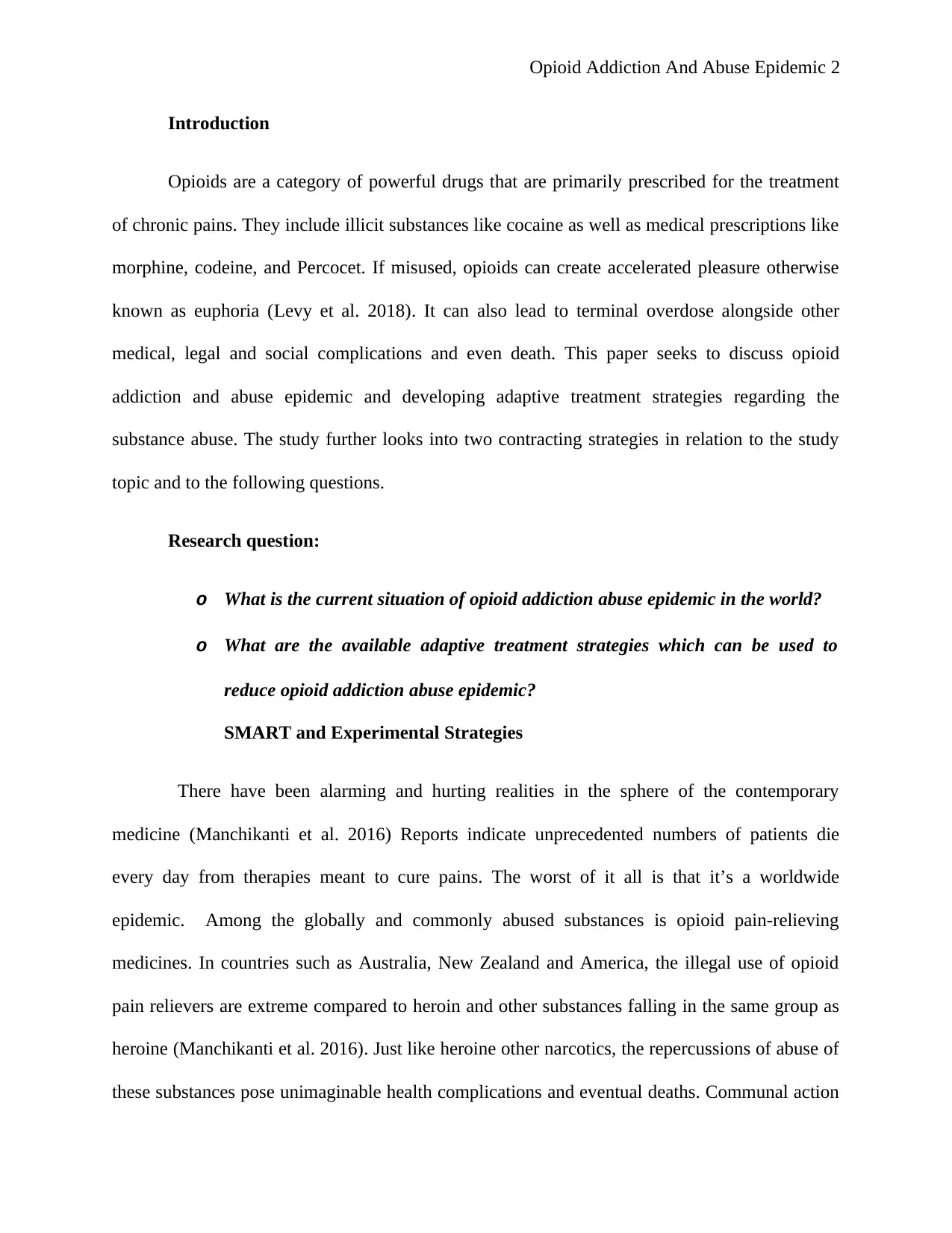
Opioid Addiction And Abuse Epidemic 2
Introduction
Opioids are a category of powerful drugs that are primarily prescribed for the treatment
of chronic pains. They include illicit substances like cocaine as well as medical prescriptions like
morphine, codeine, and Percocet. If misused, opioids can create accelerated pleasure otherwise
known as euphoria (Levy et al. 2018). It can also lead to terminal overdose alongside other
medical, legal and social complications and even death. This paper seeks to discuss opioid
addiction and abuse epidemic and developing adaptive treatment strategies regarding the
substance abuse. The study further looks into two contracting strategies in relation to the study
topic and to the following questions.
Research question:
o What is the current situation of opioid addiction abuse epidemic in the world?
o What are the available adaptive treatment strategies which can be used to
reduce opioid addiction abuse epidemic?
SMART and Experimental Strategies
There have been alarming and hurting realities in the sphere of the contemporary
medicine (Manchikanti et al. 2016) Reports indicate unprecedented numbers of patients die
every day from therapies meant to cure pains. The worst of it all is that it’s a worldwide
epidemic. Among the globally and commonly abused substances is opioid pain-relieving
medicines. In countries such as Australia, New Zealand and America, the illegal use of opioid
pain relievers are extreme compared to heroin and other substances falling in the same group as
heroine (Manchikanti et al. 2016). Just like heroine other narcotics, the repercussions of abuse of
these substances pose unimaginable health complications and eventual deaths. Communal action
Introduction
Opioids are a category of powerful drugs that are primarily prescribed for the treatment
of chronic pains. They include illicit substances like cocaine as well as medical prescriptions like
morphine, codeine, and Percocet. If misused, opioids can create accelerated pleasure otherwise
known as euphoria (Levy et al. 2018). It can also lead to terminal overdose alongside other
medical, legal and social complications and even death. This paper seeks to discuss opioid
addiction and abuse epidemic and developing adaptive treatment strategies regarding the
substance abuse. The study further looks into two contracting strategies in relation to the study
topic and to the following questions.
Research question:
o What is the current situation of opioid addiction abuse epidemic in the world?
o What are the available adaptive treatment strategies which can be used to
reduce opioid addiction abuse epidemic?
SMART and Experimental Strategies
There have been alarming and hurting realities in the sphere of the contemporary
medicine (Manchikanti et al. 2016) Reports indicate unprecedented numbers of patients die
every day from therapies meant to cure pains. The worst of it all is that it’s a worldwide
epidemic. Among the globally and commonly abused substances is opioid pain-relieving
medicines. In countries such as Australia, New Zealand and America, the illegal use of opioid
pain relievers are extreme compared to heroin and other substances falling in the same group as
heroine (Manchikanti et al. 2016). Just like heroine other narcotics, the repercussions of abuse of
these substances pose unimaginable health complications and eventual deaths. Communal action
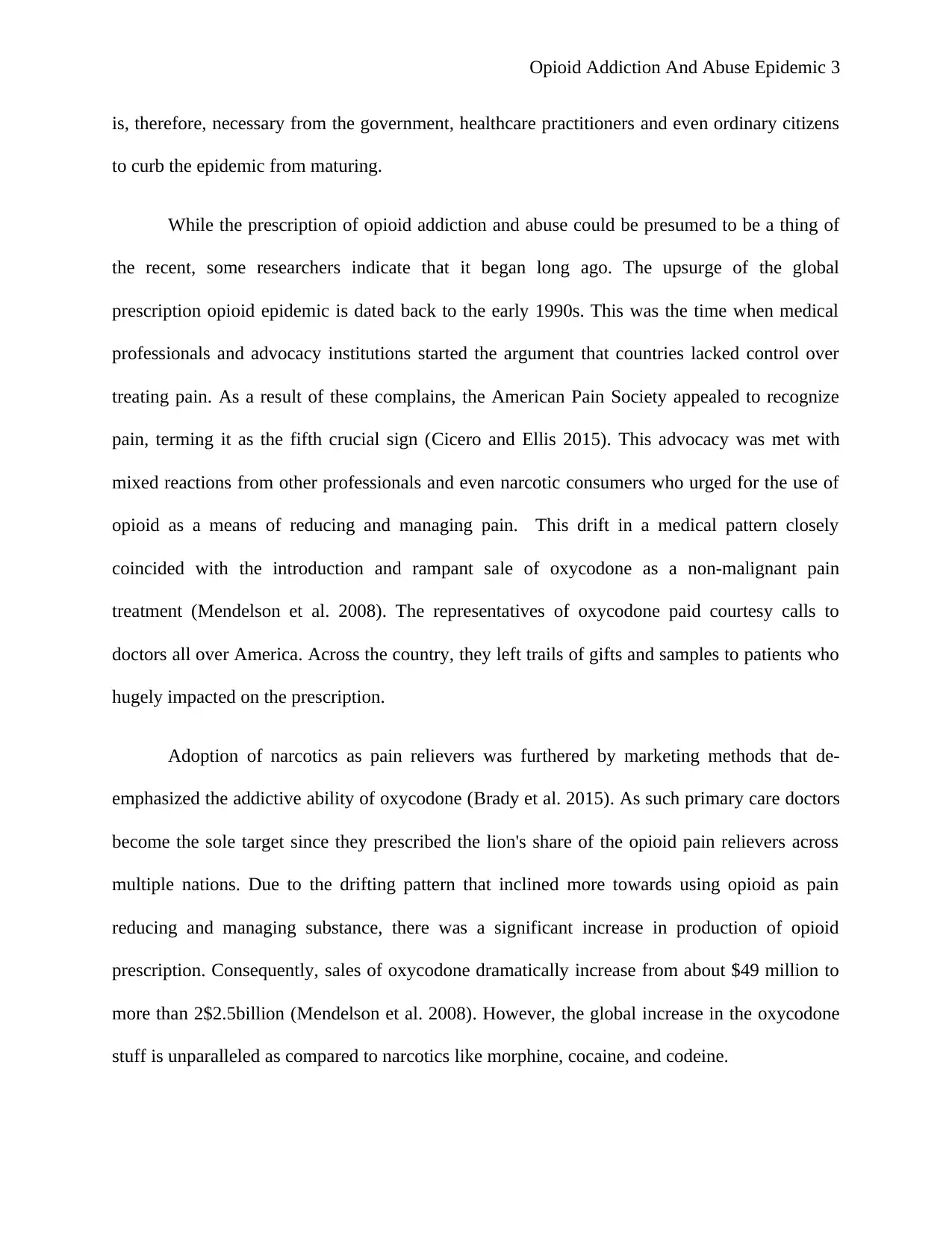
Opioid Addiction And Abuse Epidemic 3
is, therefore, necessary from the government, healthcare practitioners and even ordinary citizens
to curb the epidemic from maturing.
While the prescription of opioid addiction and abuse could be presumed to be a thing of
the recent, some researchers indicate that it began long ago. The upsurge of the global
prescription opioid epidemic is dated back to the early 1990s. This was the time when medical
professionals and advocacy institutions started the argument that countries lacked control over
treating pain. As a result of these complains, the American Pain Society appealed to recognize
pain, terming it as the fifth crucial sign (Cicero and Ellis 2015). This advocacy was met with
mixed reactions from other professionals and even narcotic consumers who urged for the use of
opioid as a means of reducing and managing pain. This drift in a medical pattern closely
coincided with the introduction and rampant sale of oxycodone as a non-malignant pain
treatment (Mendelson et al. 2008). The representatives of oxycodone paid courtesy calls to
doctors all over America. Across the country, they left trails of gifts and samples to patients who
hugely impacted on the prescription.
Adoption of narcotics as pain relievers was furthered by marketing methods that de-
emphasized the addictive ability of oxycodone (Brady et al. 2015). As such primary care doctors
become the sole target since they prescribed the lion's share of the opioid pain relievers across
multiple nations. Due to the drifting pattern that inclined more towards using opioid as pain
reducing and managing substance, there was a significant increase in production of opioid
prescription. Consequently, sales of oxycodone dramatically increase from about $49 million to
more than 2$2.5billion (Mendelson et al. 2008). However, the global increase in the oxycodone
stuff is unparalleled as compared to narcotics like morphine, cocaine, and codeine.
is, therefore, necessary from the government, healthcare practitioners and even ordinary citizens
to curb the epidemic from maturing.
While the prescription of opioid addiction and abuse could be presumed to be a thing of
the recent, some researchers indicate that it began long ago. The upsurge of the global
prescription opioid epidemic is dated back to the early 1990s. This was the time when medical
professionals and advocacy institutions started the argument that countries lacked control over
treating pain. As a result of these complains, the American Pain Society appealed to recognize
pain, terming it as the fifth crucial sign (Cicero and Ellis 2015). This advocacy was met with
mixed reactions from other professionals and even narcotic consumers who urged for the use of
opioid as a means of reducing and managing pain. This drift in a medical pattern closely
coincided with the introduction and rampant sale of oxycodone as a non-malignant pain
treatment (Mendelson et al. 2008). The representatives of oxycodone paid courtesy calls to
doctors all over America. Across the country, they left trails of gifts and samples to patients who
hugely impacted on the prescription.
Adoption of narcotics as pain relievers was furthered by marketing methods that de-
emphasized the addictive ability of oxycodone (Brady et al. 2015). As such primary care doctors
become the sole target since they prescribed the lion's share of the opioid pain relievers across
multiple nations. Due to the drifting pattern that inclined more towards using opioid as pain
reducing and managing substance, there was a significant increase in production of opioid
prescription. Consequently, sales of oxycodone dramatically increase from about $49 million to
more than 2$2.5billion (Mendelson et al. 2008). However, the global increase in the oxycodone
stuff is unparalleled as compared to narcotics like morphine, cocaine, and codeine.
⊘ This is a preview!⊘
Do you want full access?
Subscribe today to unlock all pages.

Trusted by 1+ million students worldwide
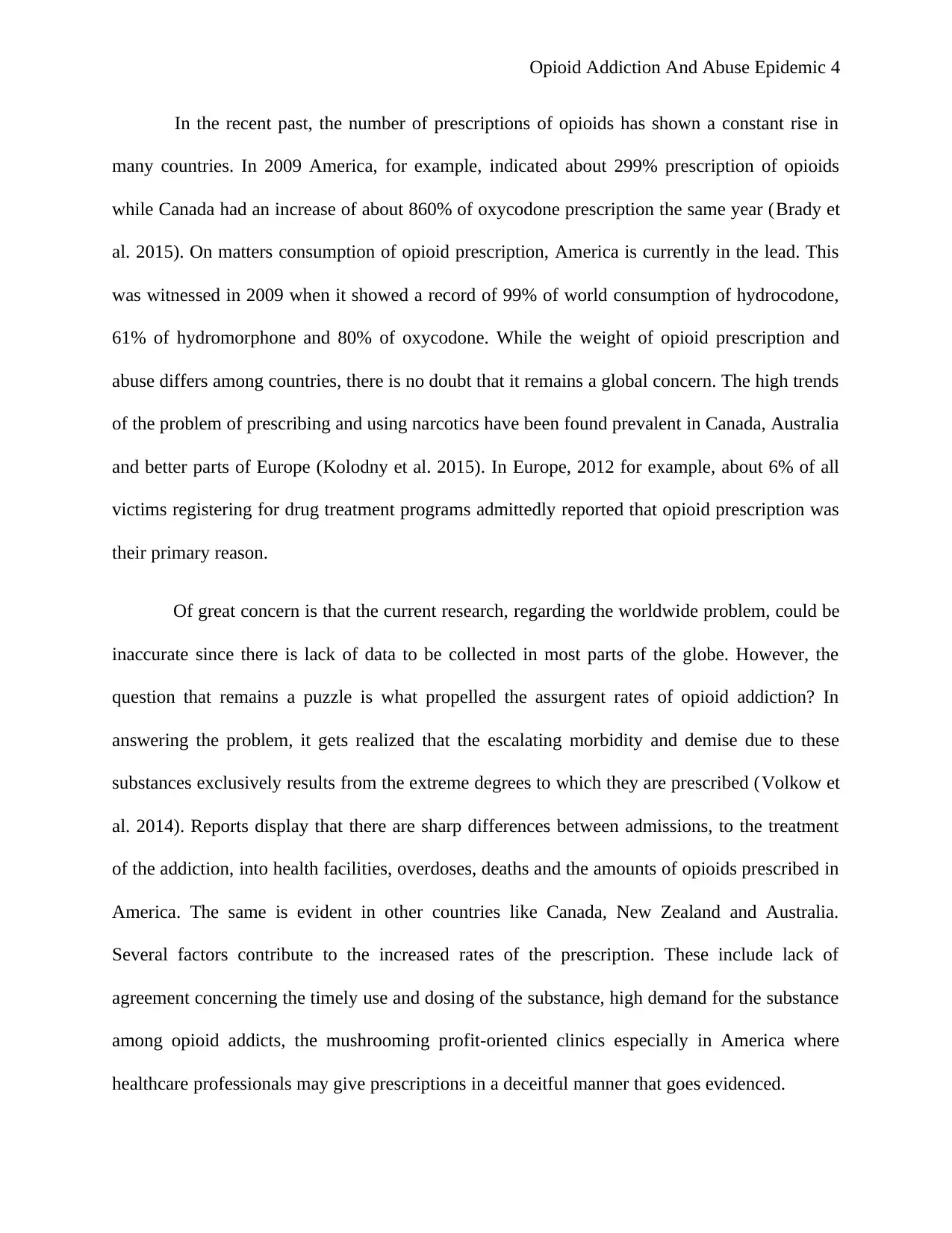
Opioid Addiction And Abuse Epidemic 4
In the recent past, the number of prescriptions of opioids has shown a constant rise in
many countries. In 2009 America, for example, indicated about 299% prescription of opioids
while Canada had an increase of about 860% of oxycodone prescription the same year (Brady et
al. 2015). On matters consumption of opioid prescription, America is currently in the lead. This
was witnessed in 2009 when it showed a record of 99% of world consumption of hydrocodone,
61% of hydromorphone and 80% of oxycodone. While the weight of opioid prescription and
abuse differs among countries, there is no doubt that it remains a global concern. The high trends
of the problem of prescribing and using narcotics have been found prevalent in Canada, Australia
and better parts of Europe (Kolodny et al. 2015). In Europe, 2012 for example, about 6% of all
victims registering for drug treatment programs admittedly reported that opioid prescription was
their primary reason.
Of great concern is that the current research, regarding the worldwide problem, could be
inaccurate since there is lack of data to be collected in most parts of the globe. However, the
question that remains a puzzle is what propelled the assurgent rates of opioid addiction? In
answering the problem, it gets realized that the escalating morbidity and demise due to these
substances exclusively results from the extreme degrees to which they are prescribed (Volkow et
al. 2014). Reports display that there are sharp differences between admissions, to the treatment
of the addiction, into health facilities, overdoses, deaths and the amounts of opioids prescribed in
America. The same is evident in other countries like Canada, New Zealand and Australia.
Several factors contribute to the increased rates of the prescription. These include lack of
agreement concerning the timely use and dosing of the substance, high demand for the substance
among opioid addicts, the mushrooming profit-oriented clinics especially in America where
healthcare professionals may give prescriptions in a deceitful manner that goes evidenced.
In the recent past, the number of prescriptions of opioids has shown a constant rise in
many countries. In 2009 America, for example, indicated about 299% prescription of opioids
while Canada had an increase of about 860% of oxycodone prescription the same year (Brady et
al. 2015). On matters consumption of opioid prescription, America is currently in the lead. This
was witnessed in 2009 when it showed a record of 99% of world consumption of hydrocodone,
61% of hydromorphone and 80% of oxycodone. While the weight of opioid prescription and
abuse differs among countries, there is no doubt that it remains a global concern. The high trends
of the problem of prescribing and using narcotics have been found prevalent in Canada, Australia
and better parts of Europe (Kolodny et al. 2015). In Europe, 2012 for example, about 6% of all
victims registering for drug treatment programs admittedly reported that opioid prescription was
their primary reason.
Of great concern is that the current research, regarding the worldwide problem, could be
inaccurate since there is lack of data to be collected in most parts of the globe. However, the
question that remains a puzzle is what propelled the assurgent rates of opioid addiction? In
answering the problem, it gets realized that the escalating morbidity and demise due to these
substances exclusively results from the extreme degrees to which they are prescribed (Volkow et
al. 2014). Reports display that there are sharp differences between admissions, to the treatment
of the addiction, into health facilities, overdoses, deaths and the amounts of opioids prescribed in
America. The same is evident in other countries like Canada, New Zealand and Australia.
Several factors contribute to the increased rates of the prescription. These include lack of
agreement concerning the timely use and dosing of the substance, high demand for the substance
among opioid addicts, the mushrooming profit-oriented clinics especially in America where
healthcare professionals may give prescriptions in a deceitful manner that goes evidenced.
Paraphrase This Document
Need a fresh take? Get an instant paraphrase of this document with our AI Paraphraser
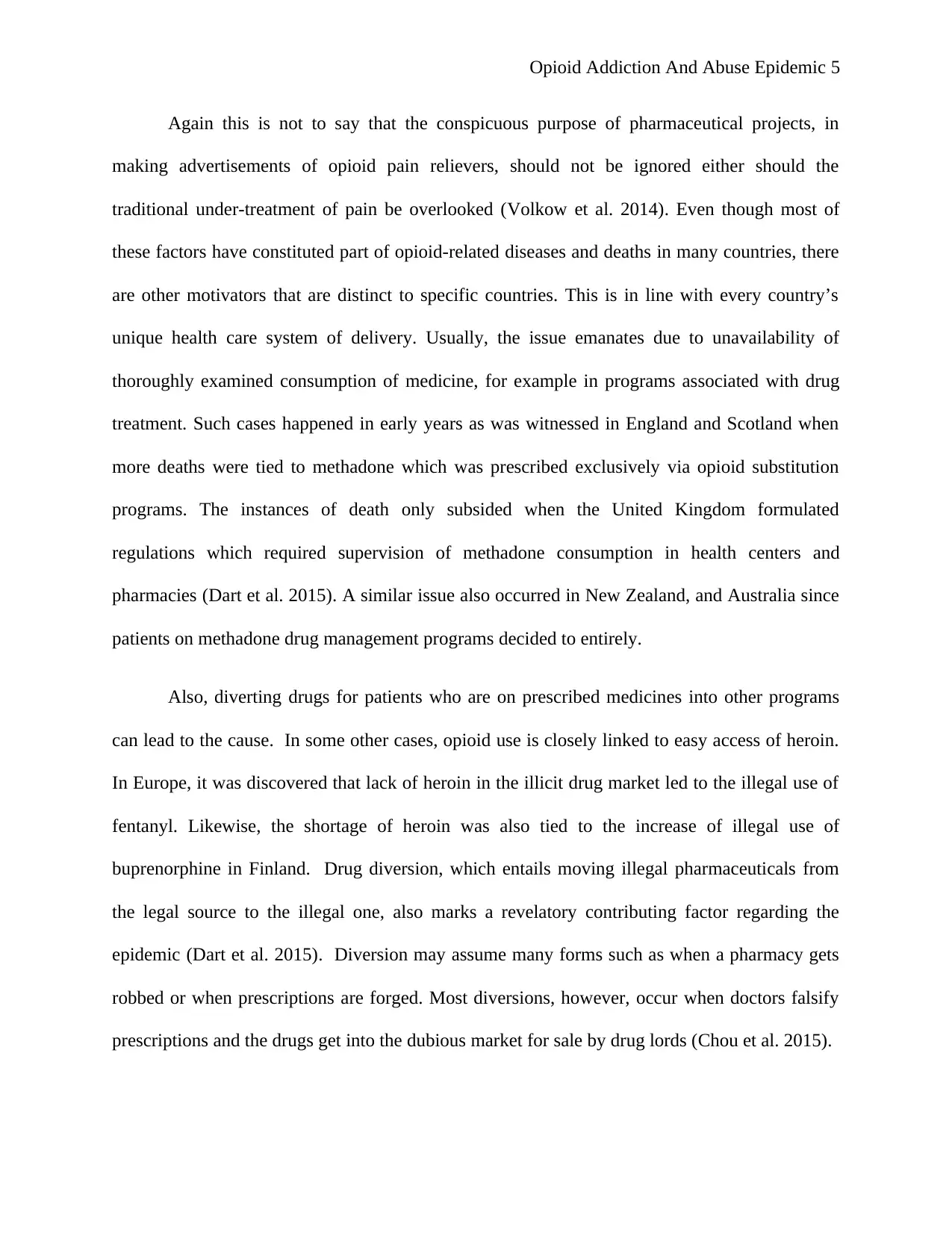
Opioid Addiction And Abuse Epidemic 5
Again this is not to say that the conspicuous purpose of pharmaceutical projects, in
making advertisements of opioid pain relievers, should not be ignored either should the
traditional under-treatment of pain be overlooked (Volkow et al. 2014). Even though most of
these factors have constituted part of opioid-related diseases and deaths in many countries, there
are other motivators that are distinct to specific countries. This is in line with every country’s
unique health care system of delivery. Usually, the issue emanates due to unavailability of
thoroughly examined consumption of medicine, for example in programs associated with drug
treatment. Such cases happened in early years as was witnessed in England and Scotland when
more deaths were tied to methadone which was prescribed exclusively via opioid substitution
programs. The instances of death only subsided when the United Kingdom formulated
regulations which required supervision of methadone consumption in health centers and
pharmacies (Dart et al. 2015). A similar issue also occurred in New Zealand, and Australia since
patients on methadone drug management programs decided to entirely.
Also, diverting drugs for patients who are on prescribed medicines into other programs
can lead to the cause. In some other cases, opioid use is closely linked to easy access of heroin.
In Europe, it was discovered that lack of heroin in the illicit drug market led to the illegal use of
fentanyl. Likewise, the shortage of heroin was also tied to the increase of illegal use of
buprenorphine in Finland. Drug diversion, which entails moving illegal pharmaceuticals from
the legal source to the illegal one, also marks a revelatory contributing factor regarding the
epidemic (Dart et al. 2015). Diversion may assume many forms such as when a pharmacy gets
robbed or when prescriptions are forged. Most diversions, however, occur when doctors falsify
prescriptions and the drugs get into the dubious market for sale by drug lords (Chou et al. 2015).
Again this is not to say that the conspicuous purpose of pharmaceutical projects, in
making advertisements of opioid pain relievers, should not be ignored either should the
traditional under-treatment of pain be overlooked (Volkow et al. 2014). Even though most of
these factors have constituted part of opioid-related diseases and deaths in many countries, there
are other motivators that are distinct to specific countries. This is in line with every country’s
unique health care system of delivery. Usually, the issue emanates due to unavailability of
thoroughly examined consumption of medicine, for example in programs associated with drug
treatment. Such cases happened in early years as was witnessed in England and Scotland when
more deaths were tied to methadone which was prescribed exclusively via opioid substitution
programs. The instances of death only subsided when the United Kingdom formulated
regulations which required supervision of methadone consumption in health centers and
pharmacies (Dart et al. 2015). A similar issue also occurred in New Zealand, and Australia since
patients on methadone drug management programs decided to entirely.
Also, diverting drugs for patients who are on prescribed medicines into other programs
can lead to the cause. In some other cases, opioid use is closely linked to easy access of heroin.
In Europe, it was discovered that lack of heroin in the illicit drug market led to the illegal use of
fentanyl. Likewise, the shortage of heroin was also tied to the increase of illegal use of
buprenorphine in Finland. Drug diversion, which entails moving illegal pharmaceuticals from
the legal source to the illegal one, also marks a revelatory contributing factor regarding the
epidemic (Dart et al. 2015). Diversion may assume many forms such as when a pharmacy gets
robbed or when prescriptions are forged. Most diversions, however, occur when doctors falsify
prescriptions and the drugs get into the dubious market for sale by drug lords (Chou et al. 2015).
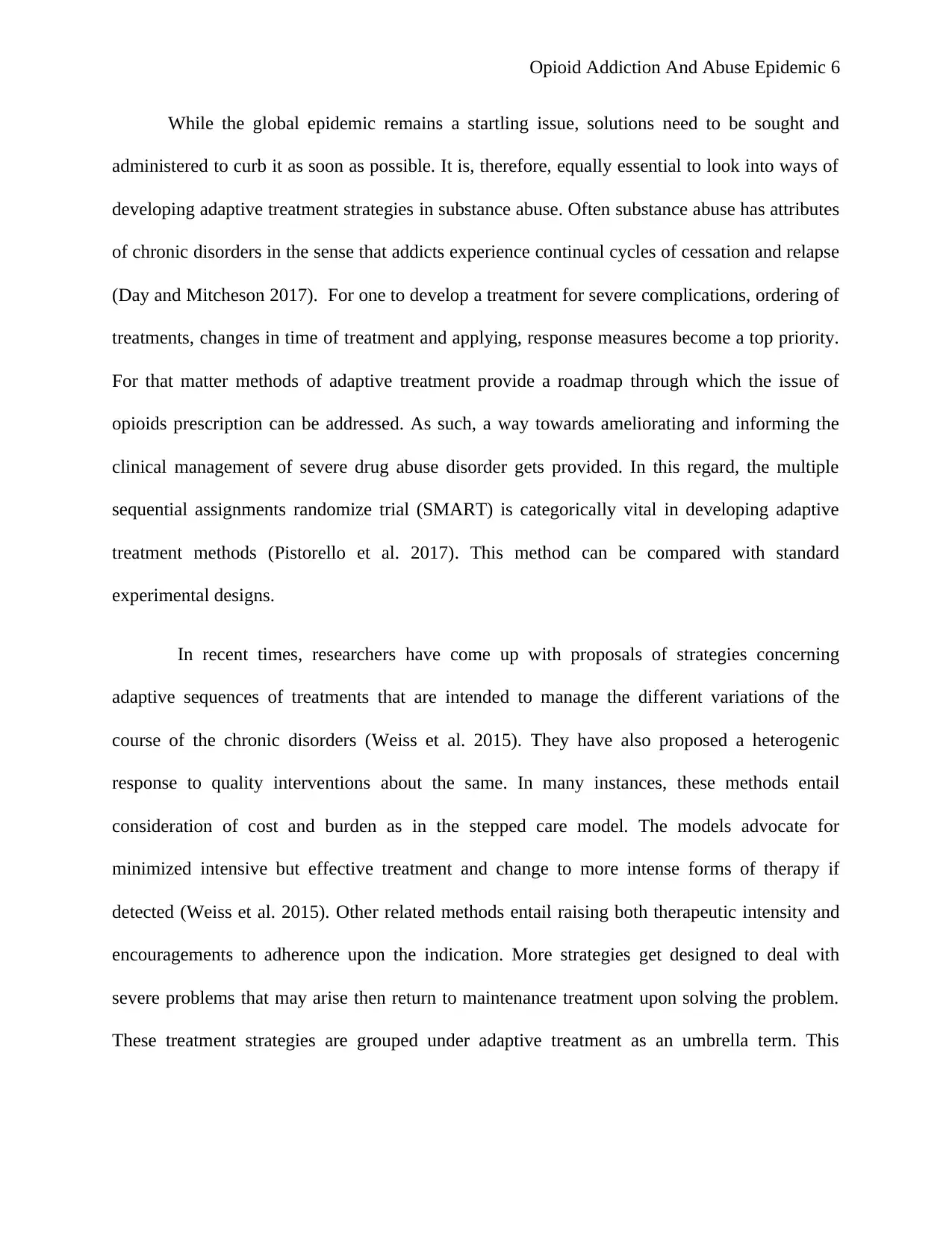
Opioid Addiction And Abuse Epidemic 6
While the global epidemic remains a startling issue, solutions need to be sought and
administered to curb it as soon as possible. It is, therefore, equally essential to look into ways of
developing adaptive treatment strategies in substance abuse. Often substance abuse has attributes
of chronic disorders in the sense that addicts experience continual cycles of cessation and relapse
(Day and Mitcheson 2017). For one to develop a treatment for severe complications, ordering of
treatments, changes in time of treatment and applying, response measures become a top priority.
For that matter methods of adaptive treatment provide a roadmap through which the issue of
opioids prescription can be addressed. As such, a way towards ameliorating and informing the
clinical management of severe drug abuse disorder gets provided. In this regard, the multiple
sequential assignments randomize trial (SMART) is categorically vital in developing adaptive
treatment methods (Pistorello et al. 2017). This method can be compared with standard
experimental designs.
In recent times, researchers have come up with proposals of strategies concerning
adaptive sequences of treatments that are intended to manage the different variations of the
course of the chronic disorders (Weiss et al. 2015). They have also proposed a heterogenic
response to quality interventions about the same. In many instances, these methods entail
consideration of cost and burden as in the stepped care model. The models advocate for
minimized intensive but effective treatment and change to more intense forms of therapy if
detected (Weiss et al. 2015). Other related methods entail raising both therapeutic intensity and
encouragements to adherence upon the indication. More strategies get designed to deal with
severe problems that may arise then return to maintenance treatment upon solving the problem.
These treatment strategies are grouped under adaptive treatment as an umbrella term. This
While the global epidemic remains a startling issue, solutions need to be sought and
administered to curb it as soon as possible. It is, therefore, equally essential to look into ways of
developing adaptive treatment strategies in substance abuse. Often substance abuse has attributes
of chronic disorders in the sense that addicts experience continual cycles of cessation and relapse
(Day and Mitcheson 2017). For one to develop a treatment for severe complications, ordering of
treatments, changes in time of treatment and applying, response measures become a top priority.
For that matter methods of adaptive treatment provide a roadmap through which the issue of
opioids prescription can be addressed. As such, a way towards ameliorating and informing the
clinical management of severe drug abuse disorder gets provided. In this regard, the multiple
sequential assignments randomize trial (SMART) is categorically vital in developing adaptive
treatment methods (Pistorello et al. 2017). This method can be compared with standard
experimental designs.
In recent times, researchers have come up with proposals of strategies concerning
adaptive sequences of treatments that are intended to manage the different variations of the
course of the chronic disorders (Weiss et al. 2015). They have also proposed a heterogenic
response to quality interventions about the same. In many instances, these methods entail
consideration of cost and burden as in the stepped care model. The models advocate for
minimized intensive but effective treatment and change to more intense forms of therapy if
detected (Weiss et al. 2015). Other related methods entail raising both therapeutic intensity and
encouragements to adherence upon the indication. More strategies get designed to deal with
severe problems that may arise then return to maintenance treatment upon solving the problem.
These treatment strategies are grouped under adaptive treatment as an umbrella term. This
⊘ This is a preview!⊘
Do you want full access?
Subscribe today to unlock all pages.

Trusted by 1+ million students worldwide
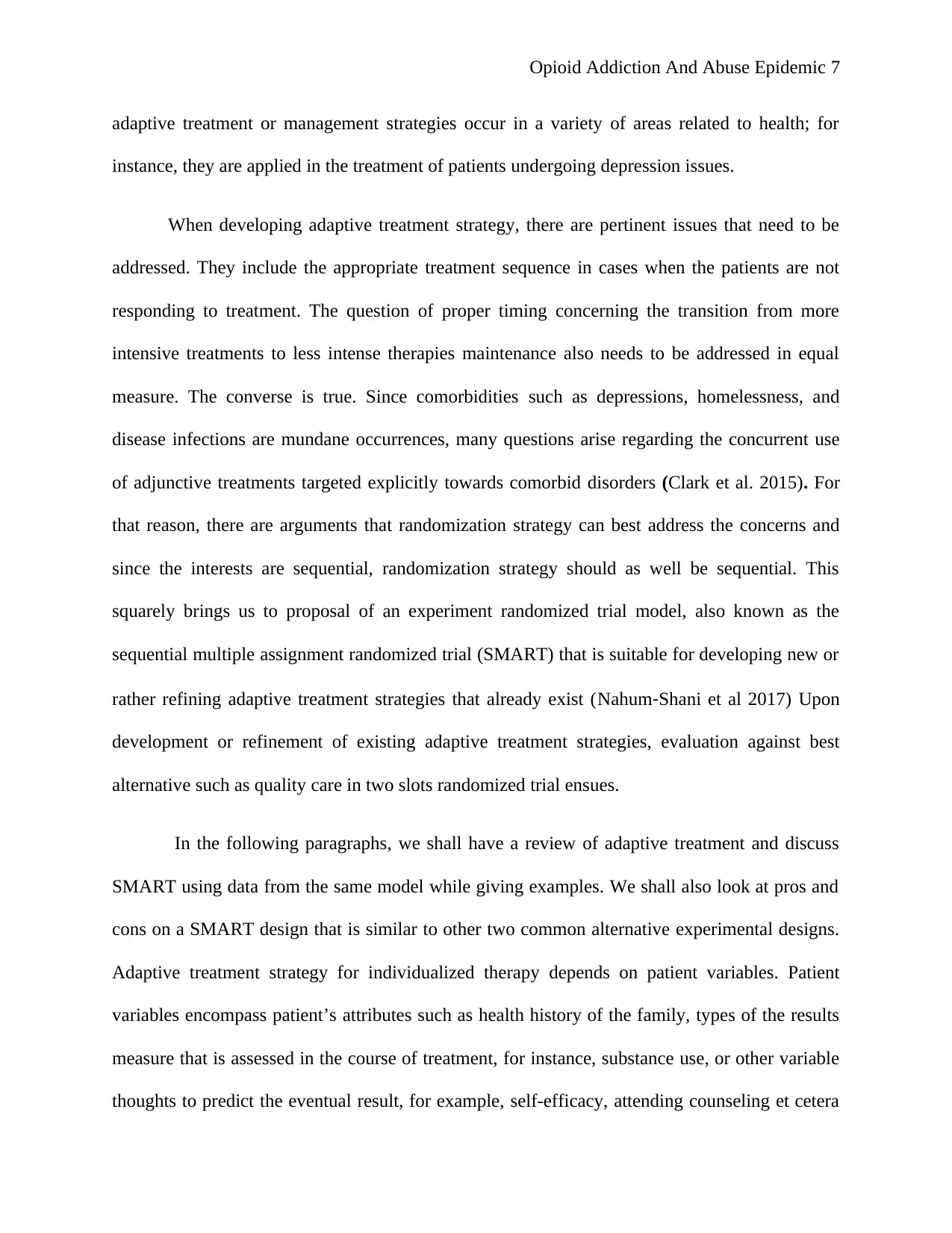
Opioid Addiction And Abuse Epidemic 7
adaptive treatment or management strategies occur in a variety of areas related to health; for
instance, they are applied in the treatment of patients undergoing depression issues.
When developing adaptive treatment strategy, there are pertinent issues that need to be
addressed. They include the appropriate treatment sequence in cases when the patients are not
responding to treatment. The question of proper timing concerning the transition from more
intensive treatments to less intense therapies maintenance also needs to be addressed in equal
measure. The converse is true. Since comorbidities such as depressions, homelessness, and
disease infections are mundane occurrences, many questions arise regarding the concurrent use
of adjunctive treatments targeted explicitly towards comorbid disorders (Clark et al. 2015). For
that reason, there are arguments that randomization strategy can best address the concerns and
since the interests are sequential, randomization strategy should as well be sequential. This
squarely brings us to proposal of an experiment randomized trial model, also known as the
sequential multiple assignment randomized trial (SMART) that is suitable for developing new or
rather refining adaptive treatment strategies that already exist (Nahum‐Shani et al 2017) Upon
development or refinement of existing adaptive treatment strategies, evaluation against best
alternative such as quality care in two slots randomized trial ensues.
In the following paragraphs, we shall have a review of adaptive treatment and discuss
SMART using data from the same model while giving examples. We shall also look at pros and
cons on a SMART design that is similar to other two common alternative experimental designs.
Adaptive treatment strategy for individualized therapy depends on patient variables. Patient
variables encompass patient’s attributes such as health history of the family, types of the results
measure that is assessed in the course of treatment, for instance, substance use, or other variable
thoughts to predict the eventual result, for example, self-efficacy, attending counseling et cetera
adaptive treatment or management strategies occur in a variety of areas related to health; for
instance, they are applied in the treatment of patients undergoing depression issues.
When developing adaptive treatment strategy, there are pertinent issues that need to be
addressed. They include the appropriate treatment sequence in cases when the patients are not
responding to treatment. The question of proper timing concerning the transition from more
intensive treatments to less intense therapies maintenance also needs to be addressed in equal
measure. The converse is true. Since comorbidities such as depressions, homelessness, and
disease infections are mundane occurrences, many questions arise regarding the concurrent use
of adjunctive treatments targeted explicitly towards comorbid disorders (Clark et al. 2015). For
that reason, there are arguments that randomization strategy can best address the concerns and
since the interests are sequential, randomization strategy should as well be sequential. This
squarely brings us to proposal of an experiment randomized trial model, also known as the
sequential multiple assignment randomized trial (SMART) that is suitable for developing new or
rather refining adaptive treatment strategies that already exist (Nahum‐Shani et al 2017) Upon
development or refinement of existing adaptive treatment strategies, evaluation against best
alternative such as quality care in two slots randomized trial ensues.
In the following paragraphs, we shall have a review of adaptive treatment and discuss
SMART using data from the same model while giving examples. We shall also look at pros and
cons on a SMART design that is similar to other two common alternative experimental designs.
Adaptive treatment strategy for individualized therapy depends on patient variables. Patient
variables encompass patient’s attributes such as health history of the family, types of the results
measure that is assessed in the course of treatment, for instance, substance use, or other variable
thoughts to predict the eventual result, for example, self-efficacy, attending counseling et cetera
Paraphrase This Document
Need a fresh take? Get an instant paraphrase of this document with our AI Paraphraser
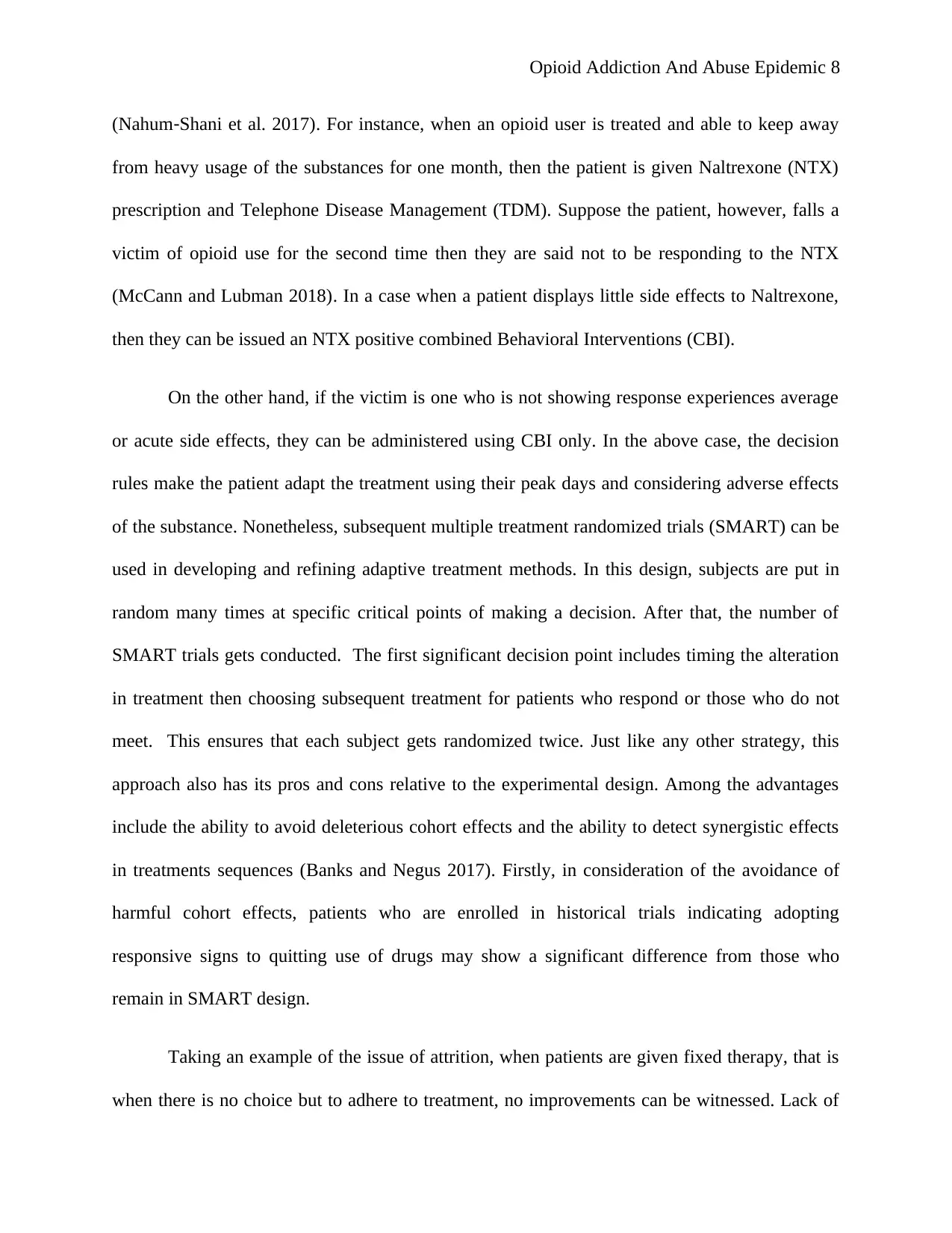
Opioid Addiction And Abuse Epidemic 8
(Nahum‐Shani et al. 2017). For instance, when an opioid user is treated and able to keep away
from heavy usage of the substances for one month, then the patient is given Naltrexone (NTX)
prescription and Telephone Disease Management (TDM). Suppose the patient, however, falls a
victim of opioid use for the second time then they are said not to be responding to the NTX
(McCann and Lubman 2018). In a case when a patient displays little side effects to Naltrexone,
then they can be issued an NTX positive combined Behavioral Interventions (CBI).
On the other hand, if the victim is one who is not showing response experiences average
or acute side effects, they can be administered using CBI only. In the above case, the decision
rules make the patient adapt the treatment using their peak days and considering adverse effects
of the substance. Nonetheless, subsequent multiple treatment randomized trials (SMART) can be
used in developing and refining adaptive treatment methods. In this design, subjects are put in
random many times at specific critical points of making a decision. After that, the number of
SMART trials gets conducted. The first significant decision point includes timing the alteration
in treatment then choosing subsequent treatment for patients who respond or those who do not
meet. This ensures that each subject gets randomized twice. Just like any other strategy, this
approach also has its pros and cons relative to the experimental design. Among the advantages
include the ability to avoid deleterious cohort effects and the ability to detect synergistic effects
in treatments sequences (Banks and Negus 2017). Firstly, in consideration of the avoidance of
harmful cohort effects, patients who are enrolled in historical trials indicating adopting
responsive signs to quitting use of drugs may show a significant difference from those who
remain in SMART design.
Taking an example of the issue of attrition, when patients are given fixed therapy, that is
when there is no choice but to adhere to treatment, no improvements can be witnessed. Lack of
(Nahum‐Shani et al. 2017). For instance, when an opioid user is treated and able to keep away
from heavy usage of the substances for one month, then the patient is given Naltrexone (NTX)
prescription and Telephone Disease Management (TDM). Suppose the patient, however, falls a
victim of opioid use for the second time then they are said not to be responding to the NTX
(McCann and Lubman 2018). In a case when a patient displays little side effects to Naltrexone,
then they can be issued an NTX positive combined Behavioral Interventions (CBI).
On the other hand, if the victim is one who is not showing response experiences average
or acute side effects, they can be administered using CBI only. In the above case, the decision
rules make the patient adapt the treatment using their peak days and considering adverse effects
of the substance. Nonetheless, subsequent multiple treatment randomized trials (SMART) can be
used in developing and refining adaptive treatment methods. In this design, subjects are put in
random many times at specific critical points of making a decision. After that, the number of
SMART trials gets conducted. The first significant decision point includes timing the alteration
in treatment then choosing subsequent treatment for patients who respond or those who do not
meet. This ensures that each subject gets randomized twice. Just like any other strategy, this
approach also has its pros and cons relative to the experimental design. Among the advantages
include the ability to avoid deleterious cohort effects and the ability to detect synergistic effects
in treatments sequences (Banks and Negus 2017). Firstly, in consideration of the avoidance of
harmful cohort effects, patients who are enrolled in historical trials indicating adopting
responsive signs to quitting use of drugs may show a significant difference from those who
remain in SMART design.
Taking an example of the issue of attrition, when patients are given fixed therapy, that is
when there is no choice but to adhere to treatment, no improvements can be witnessed. Lack of
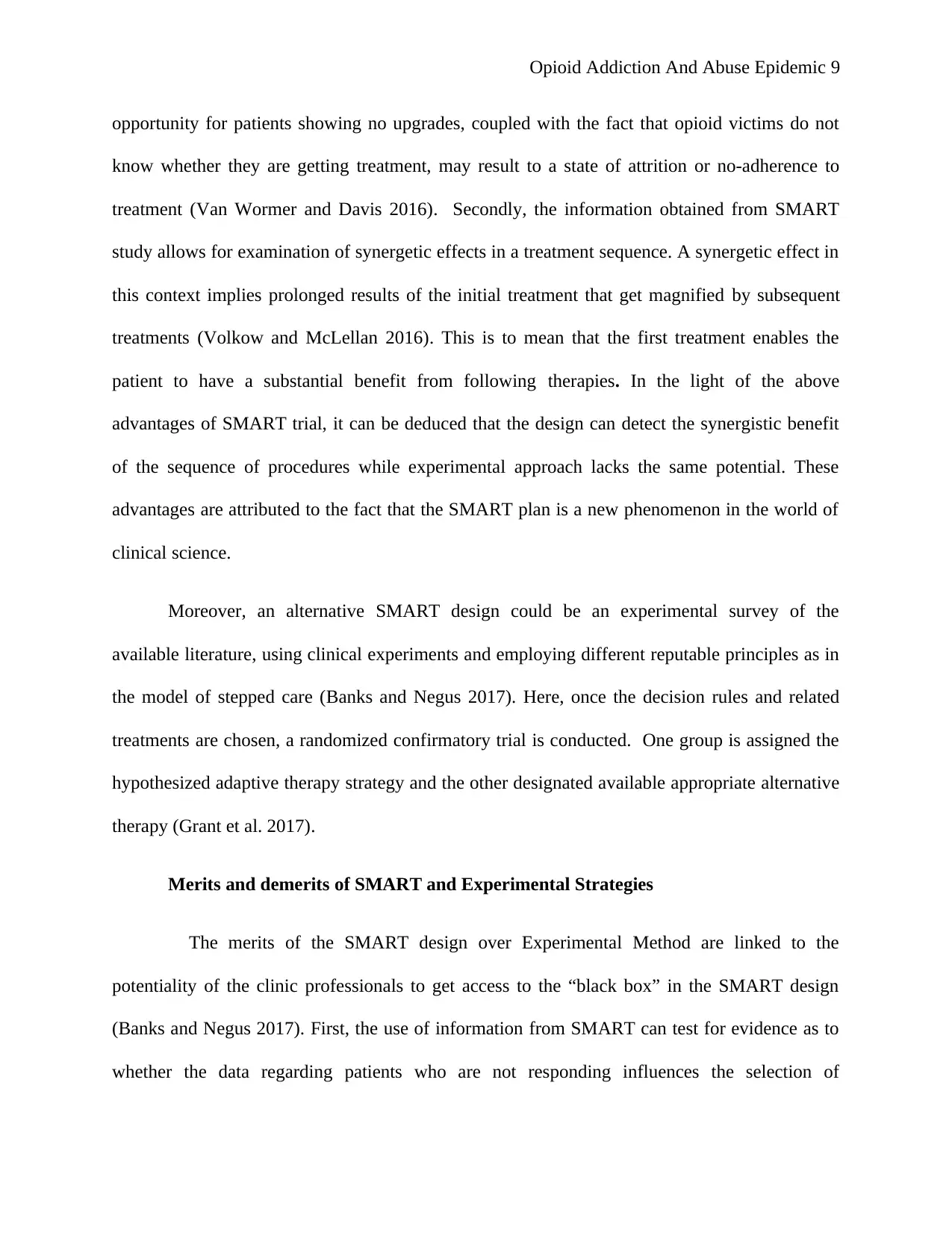
Opioid Addiction And Abuse Epidemic 9
opportunity for patients showing no upgrades, coupled with the fact that opioid victims do not
know whether they are getting treatment, may result to a state of attrition or no-adherence to
treatment (Van Wormer and Davis 2016). Secondly, the information obtained from SMART
study allows for examination of synergetic effects in a treatment sequence. A synergetic effect in
this context implies prolonged results of the initial treatment that get magnified by subsequent
treatments (Volkow and McLellan 2016). This is to mean that the first treatment enables the
patient to have a substantial benefit from following therapies. In the light of the above
advantages of SMART trial, it can be deduced that the design can detect the synergistic benefit
of the sequence of procedures while experimental approach lacks the same potential. These
advantages are attributed to the fact that the SMART plan is a new phenomenon in the world of
clinical science.
Moreover, an alternative SMART design could be an experimental survey of the
available literature, using clinical experiments and employing different reputable principles as in
the model of stepped care (Banks and Negus 2017). Here, once the decision rules and related
treatments are chosen, a randomized confirmatory trial is conducted. One group is assigned the
hypothesized adaptive therapy strategy and the other designated available appropriate alternative
therapy (Grant et al. 2017).
Merits and demerits of SMART and Experimental Strategies
The merits of the SMART design over Experimental Method are linked to the
potentiality of the clinic professionals to get access to the “black box” in the SMART design
(Banks and Negus 2017). First, the use of information from SMART can test for evidence as to
whether the data regarding patients who are not responding influences the selection of
opportunity for patients showing no upgrades, coupled with the fact that opioid victims do not
know whether they are getting treatment, may result to a state of attrition or no-adherence to
treatment (Van Wormer and Davis 2016). Secondly, the information obtained from SMART
study allows for examination of synergetic effects in a treatment sequence. A synergetic effect in
this context implies prolonged results of the initial treatment that get magnified by subsequent
treatments (Volkow and McLellan 2016). This is to mean that the first treatment enables the
patient to have a substantial benefit from following therapies. In the light of the above
advantages of SMART trial, it can be deduced that the design can detect the synergistic benefit
of the sequence of procedures while experimental approach lacks the same potential. These
advantages are attributed to the fact that the SMART plan is a new phenomenon in the world of
clinical science.
Moreover, an alternative SMART design could be an experimental survey of the
available literature, using clinical experiments and employing different reputable principles as in
the model of stepped care (Banks and Negus 2017). Here, once the decision rules and related
treatments are chosen, a randomized confirmatory trial is conducted. One group is assigned the
hypothesized adaptive therapy strategy and the other designated available appropriate alternative
therapy (Grant et al. 2017).
Merits and demerits of SMART and Experimental Strategies
The merits of the SMART design over Experimental Method are linked to the
potentiality of the clinic professionals to get access to the “black box” in the SMART design
(Banks and Negus 2017). First, the use of information from SMART can test for evidence as to
whether the data regarding patients who are not responding influences the selection of
⊘ This is a preview!⊘
Do you want full access?
Subscribe today to unlock all pages.

Trusted by 1+ million students worldwide
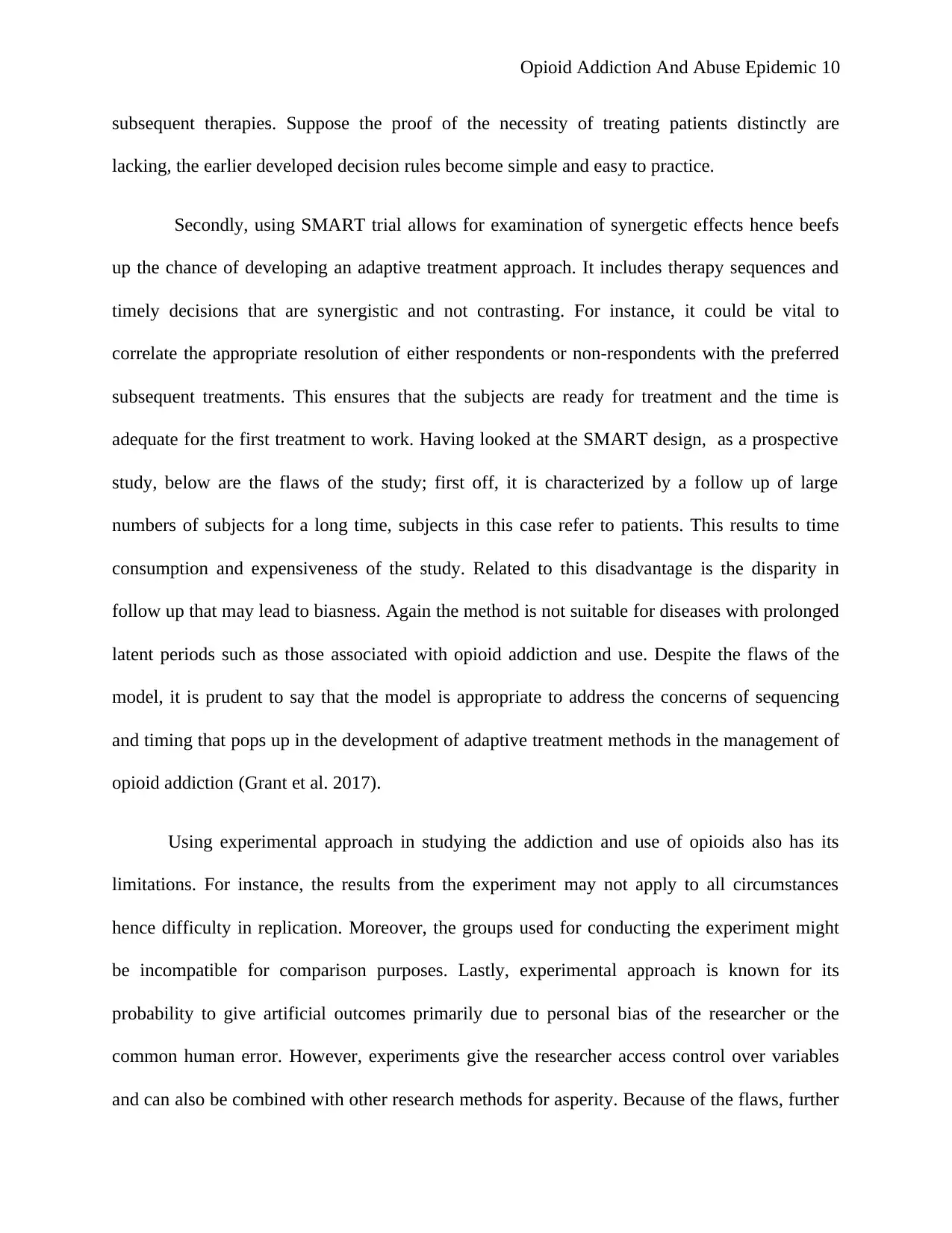
Opioid Addiction And Abuse Epidemic 10
subsequent therapies. Suppose the proof of the necessity of treating patients distinctly are
lacking, the earlier developed decision rules become simple and easy to practice.
Secondly, using SMART trial allows for examination of synergetic effects hence beefs
up the chance of developing an adaptive treatment approach. It includes therapy sequences and
timely decisions that are synergistic and not contrasting. For instance, it could be vital to
correlate the appropriate resolution of either respondents or non-respondents with the preferred
subsequent treatments. This ensures that the subjects are ready for treatment and the time is
adequate for the first treatment to work. Having looked at the SMART design, as a prospective
study, below are the flaws of the study; first off, it is characterized by a follow up of large
numbers of subjects for a long time, subjects in this case refer to patients. This results to time
consumption and expensiveness of the study. Related to this disadvantage is the disparity in
follow up that may lead to biasness. Again the method is not suitable for diseases with prolonged
latent periods such as those associated with opioid addiction and use. Despite the flaws of the
model, it is prudent to say that the model is appropriate to address the concerns of sequencing
and timing that pops up in the development of adaptive treatment methods in the management of
opioid addiction (Grant et al. 2017).
Using experimental approach in studying the addiction and use of opioids also has its
limitations. For instance, the results from the experiment may not apply to all circumstances
hence difficulty in replication. Moreover, the groups used for conducting the experiment might
be incompatible for comparison purposes. Lastly, experimental approach is known for its
probability to give artificial outcomes primarily due to personal bias of the researcher or the
common human error. However, experiments give the researcher access control over variables
and can also be combined with other research methods for asperity. Because of the flaws, further
subsequent therapies. Suppose the proof of the necessity of treating patients distinctly are
lacking, the earlier developed decision rules become simple and easy to practice.
Secondly, using SMART trial allows for examination of synergetic effects hence beefs
up the chance of developing an adaptive treatment approach. It includes therapy sequences and
timely decisions that are synergistic and not contrasting. For instance, it could be vital to
correlate the appropriate resolution of either respondents or non-respondents with the preferred
subsequent treatments. This ensures that the subjects are ready for treatment and the time is
adequate for the first treatment to work. Having looked at the SMART design, as a prospective
study, below are the flaws of the study; first off, it is characterized by a follow up of large
numbers of subjects for a long time, subjects in this case refer to patients. This results to time
consumption and expensiveness of the study. Related to this disadvantage is the disparity in
follow up that may lead to biasness. Again the method is not suitable for diseases with prolonged
latent periods such as those associated with opioid addiction and use. Despite the flaws of the
model, it is prudent to say that the model is appropriate to address the concerns of sequencing
and timing that pops up in the development of adaptive treatment methods in the management of
opioid addiction (Grant et al. 2017).
Using experimental approach in studying the addiction and use of opioids also has its
limitations. For instance, the results from the experiment may not apply to all circumstances
hence difficulty in replication. Moreover, the groups used for conducting the experiment might
be incompatible for comparison purposes. Lastly, experimental approach is known for its
probability to give artificial outcomes primarily due to personal bias of the researcher or the
common human error. However, experiments give the researcher access control over variables
and can also be combined with other research methods for asperity. Because of the flaws, further
Paraphrase This Document
Need a fresh take? Get an instant paraphrase of this document with our AI Paraphraser
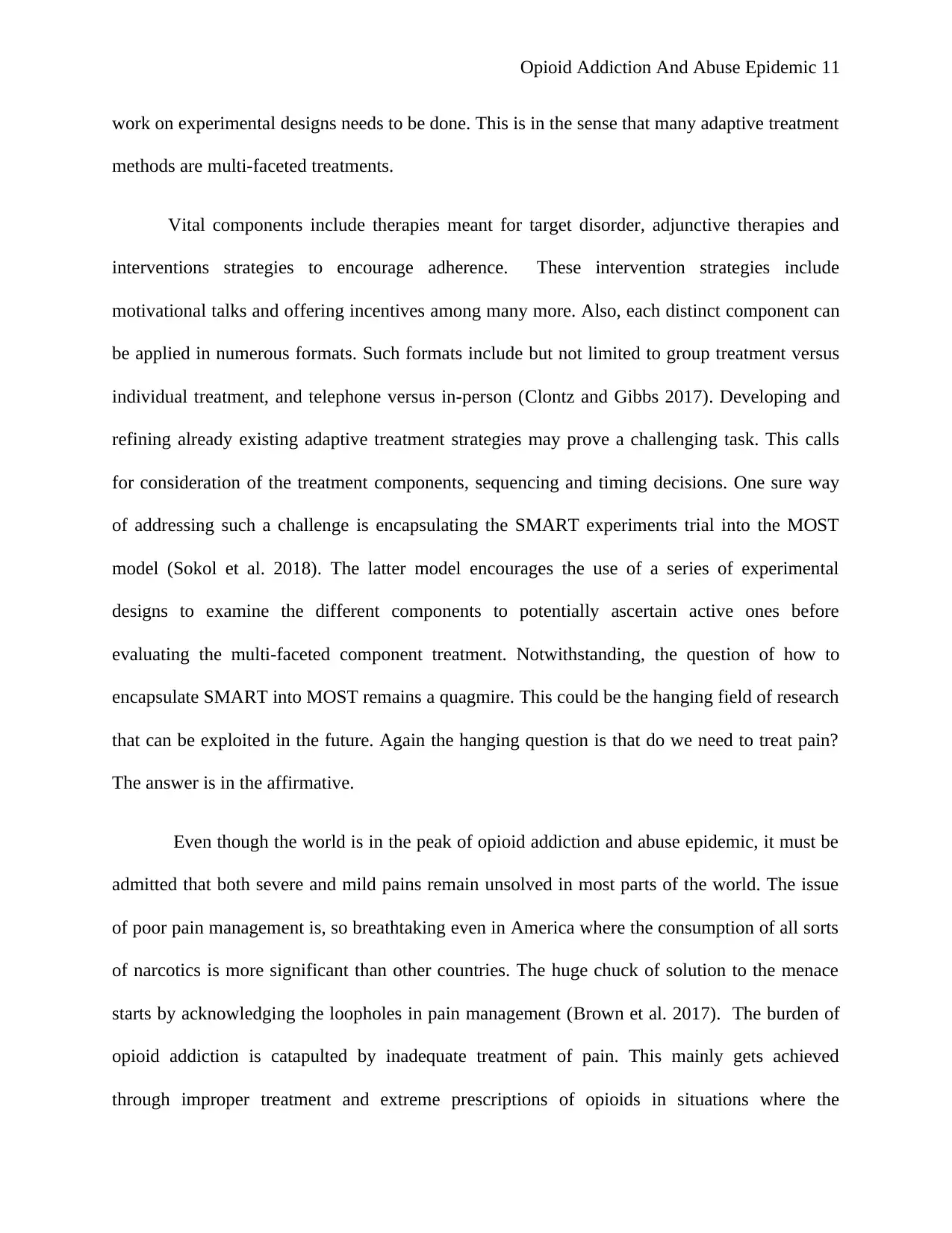
Opioid Addiction And Abuse Epidemic 11
work on experimental designs needs to be done. This is in the sense that many adaptive treatment
methods are multi-faceted treatments.
Vital components include therapies meant for target disorder, adjunctive therapies and
interventions strategies to encourage adherence. These intervention strategies include
motivational talks and offering incentives among many more. Also, each distinct component can
be applied in numerous formats. Such formats include but not limited to group treatment versus
individual treatment, and telephone versus in-person (Clontz and Gibbs 2017). Developing and
refining already existing adaptive treatment strategies may prove a challenging task. This calls
for consideration of the treatment components, sequencing and timing decisions. One sure way
of addressing such a challenge is encapsulating the SMART experiments trial into the MOST
model (Sokol et al. 2018). The latter model encourages the use of a series of experimental
designs to examine the different components to potentially ascertain active ones before
evaluating the multi-faceted component treatment. Notwithstanding, the question of how to
encapsulate SMART into MOST remains a quagmire. This could be the hanging field of research
that can be exploited in the future. Again the hanging question is that do we need to treat pain?
The answer is in the affirmative.
Even though the world is in the peak of opioid addiction and abuse epidemic, it must be
admitted that both severe and mild pains remain unsolved in most parts of the world. The issue
of poor pain management is, so breathtaking even in America where the consumption of all sorts
of narcotics is more significant than other countries. The huge chuck of solution to the menace
starts by acknowledging the loopholes in pain management (Brown et al. 2017). The burden of
opioid addiction is catapulted by inadequate treatment of pain. This mainly gets achieved
through improper treatment and extreme prescriptions of opioids in situations where the
work on experimental designs needs to be done. This is in the sense that many adaptive treatment
methods are multi-faceted treatments.
Vital components include therapies meant for target disorder, adjunctive therapies and
interventions strategies to encourage adherence. These intervention strategies include
motivational talks and offering incentives among many more. Also, each distinct component can
be applied in numerous formats. Such formats include but not limited to group treatment versus
individual treatment, and telephone versus in-person (Clontz and Gibbs 2017). Developing and
refining already existing adaptive treatment strategies may prove a challenging task. This calls
for consideration of the treatment components, sequencing and timing decisions. One sure way
of addressing such a challenge is encapsulating the SMART experiments trial into the MOST
model (Sokol et al. 2018). The latter model encourages the use of a series of experimental
designs to examine the different components to potentially ascertain active ones before
evaluating the multi-faceted component treatment. Notwithstanding, the question of how to
encapsulate SMART into MOST remains a quagmire. This could be the hanging field of research
that can be exploited in the future. Again the hanging question is that do we need to treat pain?
The answer is in the affirmative.
Even though the world is in the peak of opioid addiction and abuse epidemic, it must be
admitted that both severe and mild pains remain unsolved in most parts of the world. The issue
of poor pain management is, so breathtaking even in America where the consumption of all sorts
of narcotics is more significant than other countries. The huge chuck of solution to the menace
starts by acknowledging the loopholes in pain management (Brown et al. 2017). The burden of
opioid addiction is catapulted by inadequate treatment of pain. This mainly gets achieved
through improper treatment and extreme prescriptions of opioids in situations where the
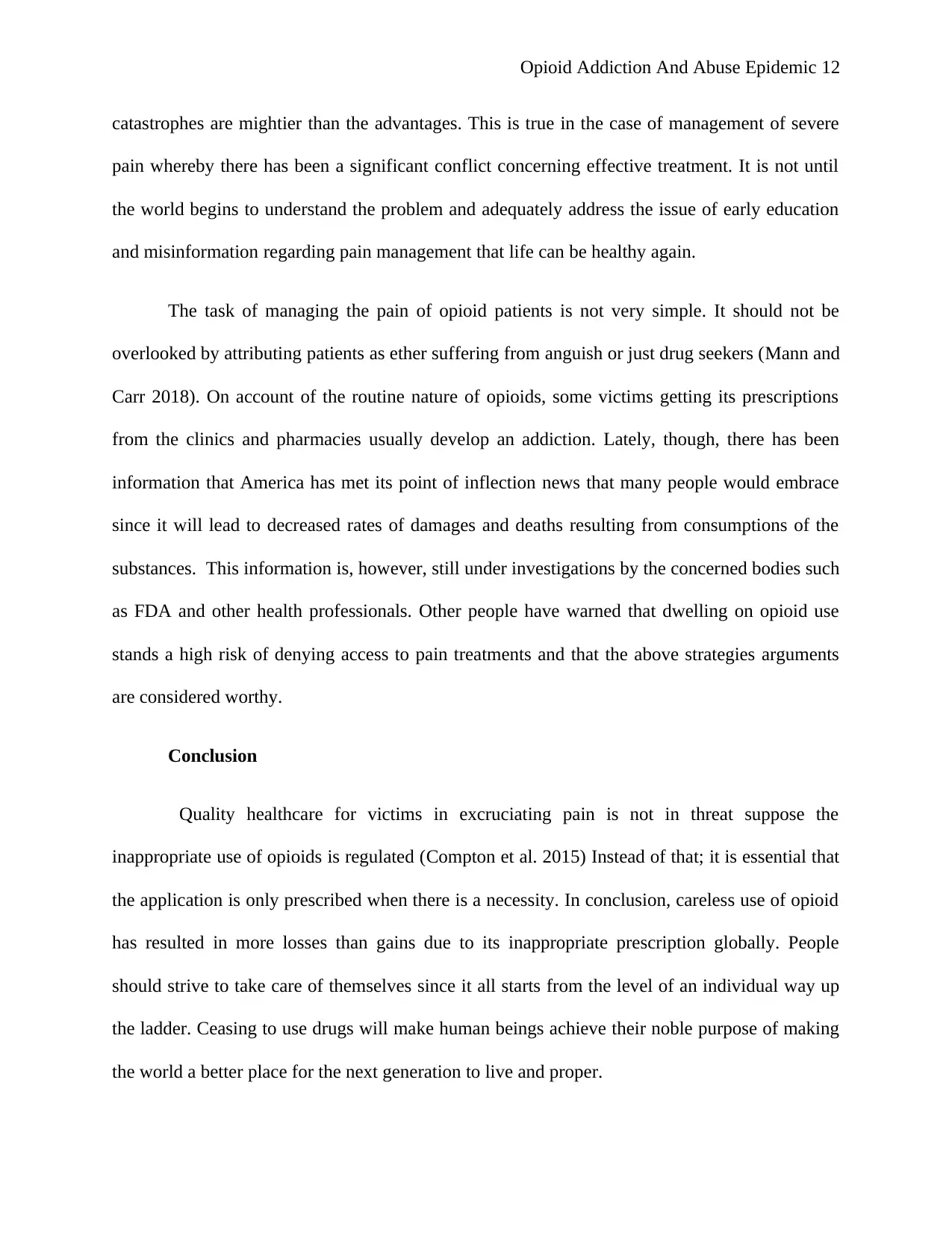
Opioid Addiction And Abuse Epidemic 12
catastrophes are mightier than the advantages. This is true in the case of management of severe
pain whereby there has been a significant conflict concerning effective treatment. It is not until
the world begins to understand the problem and adequately address the issue of early education
and misinformation regarding pain management that life can be healthy again.
The task of managing the pain of opioid patients is not very simple. It should not be
overlooked by attributing patients as ether suffering from anguish or just drug seekers (Mann and
Carr 2018). On account of the routine nature of opioids, some victims getting its prescriptions
from the clinics and pharmacies usually develop an addiction. Lately, though, there has been
information that America has met its point of inflection news that many people would embrace
since it will lead to decreased rates of damages and deaths resulting from consumptions of the
substances. This information is, however, still under investigations by the concerned bodies such
as FDA and other health professionals. Other people have warned that dwelling on opioid use
stands a high risk of denying access to pain treatments and that the above strategies arguments
are considered worthy.
Conclusion
Quality healthcare for victims in excruciating pain is not in threat suppose the
inappropriate use of opioids is regulated (Compton et al. 2015) Instead of that; it is essential that
the application is only prescribed when there is a necessity. In conclusion, careless use of opioid
has resulted in more losses than gains due to its inappropriate prescription globally. People
should strive to take care of themselves since it all starts from the level of an individual way up
the ladder. Ceasing to use drugs will make human beings achieve their noble purpose of making
the world a better place for the next generation to live and proper.
catastrophes are mightier than the advantages. This is true in the case of management of severe
pain whereby there has been a significant conflict concerning effective treatment. It is not until
the world begins to understand the problem and adequately address the issue of early education
and misinformation regarding pain management that life can be healthy again.
The task of managing the pain of opioid patients is not very simple. It should not be
overlooked by attributing patients as ether suffering from anguish or just drug seekers (Mann and
Carr 2018). On account of the routine nature of opioids, some victims getting its prescriptions
from the clinics and pharmacies usually develop an addiction. Lately, though, there has been
information that America has met its point of inflection news that many people would embrace
since it will lead to decreased rates of damages and deaths resulting from consumptions of the
substances. This information is, however, still under investigations by the concerned bodies such
as FDA and other health professionals. Other people have warned that dwelling on opioid use
stands a high risk of denying access to pain treatments and that the above strategies arguments
are considered worthy.
Conclusion
Quality healthcare for victims in excruciating pain is not in threat suppose the
inappropriate use of opioids is regulated (Compton et al. 2015) Instead of that; it is essential that
the application is only prescribed when there is a necessity. In conclusion, careless use of opioid
has resulted in more losses than gains due to its inappropriate prescription globally. People
should strive to take care of themselves since it all starts from the level of an individual way up
the ladder. Ceasing to use drugs will make human beings achieve their noble purpose of making
the world a better place for the next generation to live and proper.
⊘ This is a preview!⊘
Do you want full access?
Subscribe today to unlock all pages.

Trusted by 1+ million students worldwide
1 out of 16
Related Documents
Your All-in-One AI-Powered Toolkit for Academic Success.
+13062052269
info@desklib.com
Available 24*7 on WhatsApp / Email
![[object Object]](/_next/static/media/star-bottom.7253800d.svg)
Unlock your academic potential
Copyright © 2020–2025 A2Z Services. All Rights Reserved. Developed and managed by ZUCOL.





